Watching your hair thin can feel devastating, especially when you’ve tried countless products that promise results but deliver disappointment. The good news? Science has identified several proven methods to reverse thinning hair, with many showing measurable results within months of consistent use.
Whether you’re dealing with male pattern baldness, female pattern hair loss, or sudden hair shedding from stress or medical conditions, this comprehensive guide will walk you through evidence-based treatments that actually work. You’ll discover FDA-approved medications, natural remedies backed by research, and lifestyle changes that can help you regain the full, healthy hair you’ve been missing.
From quick-acting solutions that show results in weeks to long-term strategies for maintaining hair health, we’ll cover everything you need to know to create an effective treatment plan tailored to your specific type of hair loss.
Quick-Acting Solutions to Reverse Hair Thinning
When you’re looking to reverse thinning hair quickly, several scientifically-proven options can deliver visible results within months.
FDA-Approved Topical Minoxidil
Topical minoxidil (commonly known as Rogaine) remains the gold standard for promoting hair growth. Clinical studies show that 5% minoxidil solution applied twice daily can produce visible results in 12-16 weeks. This over the counter treatment works by extending the growth phase of hair follicles and increasing blood flow to the scalp. Minoxidil was originally developed to treat high blood pressure, but it is now repurposed for hair loss due to its ability to stimulate hair follicles.
Women should typically start with 2% minoxidil, while men can use the stronger 5% concentration. Apply the solution directly to dry scalp areas where hair is thinning, allowing it to absorb completely before styling.
Prescription Finasteride for Men
Finasteride (Propecia) represents one of the most effective medical treatments for male pattern baldness, showing improvement in 90% of men within 3-6 months of consistent use. This oral medication works by blocking the conversion of testosterone to dihydrotestosterone (DHT), the hormone responsible for hair follicle miniaturization in androgenetic alopecia.
The standard dose is 1mg daily, taken with or without food. While not recommended for women of childbearing age due to potential birth defects, it can be prescribed off-label for postmenopausal women experiencing hair loss.
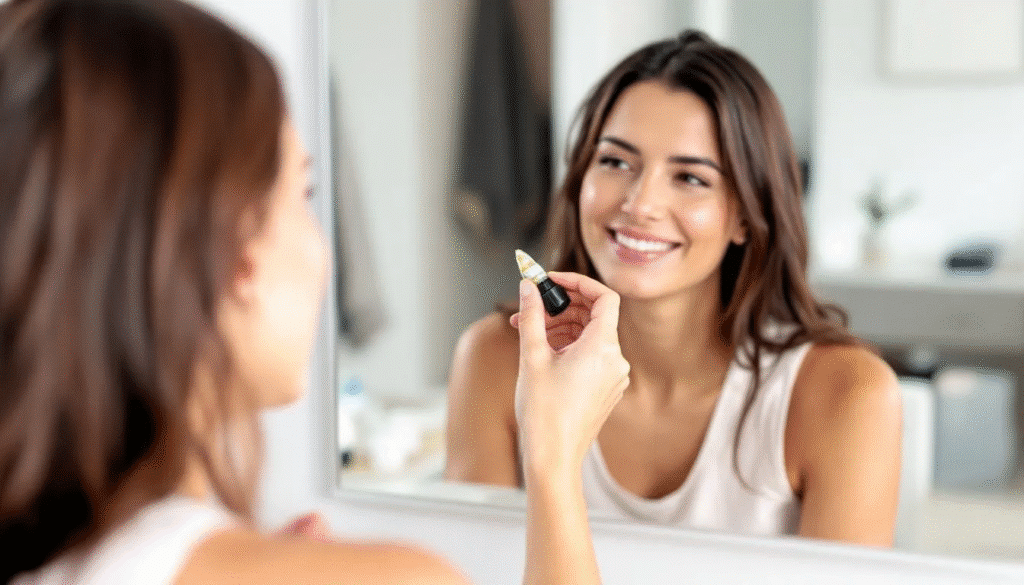
Immediate Styling Solutions
While waiting for treatments to take effect, strategic styling can immediately create the appearance of fuller hair. Volumizing shampoos and conditioners add temporary thickness to individual hairs, while root-lifting mousses can create lift at the scalp. At home treatments such as gentle hair care routines and avoiding harsh chemical processes like coloring, straightening, and perming can help protect thinning hair while waiting for regrowth.
Consider a shorter haircut that works with your current hair density rather than against it. Layered cuts can create movement and volume, while avoiding harsh chemicals in hair products prevents further damage to weakened strands.
Professional PRP Treatments
Platelet-rich plasma (PRP) injections have emerged as a promising professional treatment for hair regrowth. This procedure involves drawing your blood, processing it to concentrate the platelets, then injecting the platelet-rich plasma into areas of hair thinning.
Most patients see noticeable improvement after 3-4 sessions spaced 4-6 weeks apart. While more research is needed to establish long-term efficacy, early results suggest PRP can stimulate dormant hair follicles and promote new hair growth.
Understanding What Causes Hair Thinning
To effectively treat thinning hair, you need to understand the underlying causes affecting your hair follicle health and growth cycles. When hair may thin or fall out, some people may lose hair suddenly or gradually, depending on the underlying cause.
Androgenetic Alopecia: The Most Common Culprit
Androgenetic alopecia affects both men and women, though it manifests differently in each. This genetic condition causes hair follicles to gradually shrink over time, producing progressively thinner and shorter hairs until they eventually stop producing hair altogether.
In men, this typically begins with a receding hairline and crown thinning. Women usually experience diffuse thinning across the top of the scalp, with the hairline remaining relatively intact. The condition is driven by sensitivity to DHT, which binds to receptors in hair follicles and triggers the miniaturization process.
Telogen Effluvium: Stress-Related Hair Loss
Telogen effluvium represents a temporary form of hair loss triggered by physical stress, emotional trauma, major illness, surgery, or significant life changes. This condition pushes large numbers of hair follicles into the resting (telogen) phase simultaneously, leading to increased hair shedding 2-3 months after the triggering event.
Unlike pattern baldness, telogen effluvium typically causes diffuse hair thinning across the entire scalp. The good news is that this type of hair loss is usually reversible once the underlying cause is addressed and stress levels normalize.
Nutritional Deficiencies Affecting Hair Growth
Your hair requires certain nutrients such as iron, zinc, and vitamins to maintain healthy growth cycles. Iron deficiency anemia is particularly common in women and can significantly impact hair health. Without adequate iron, your body prioritizes essential functions over hair production, leading to increased shedding and slower regrowth.
Other nutritional deficiencies that can cause hair thinning include inadequate protein intake, B-vitamin deficiencies (particularly biotin and B12), vitamin D deficiency, and insufficient omega-3 fatty acids. A balanced diet rich in these nutrients supports optimal hair follicle function.
If dietary intake is insufficient, doctors may recommend dietary supplements like vitamins and minerals to support hair growth and address deficiencies.
Vitamin C can help enhance iron absorption, so consuming vitamin C-rich foods alongside iron sources may further support hair health.
Hormonal Changes and Imbalances
Hormonal fluctuations during menopause, pregnancy, and postpartum periods can significantly affect hair growth. During menopause, declining estrogen levels allow androgens to have a greater impact on hair follicles, often leading to thinning similar to male pattern baldness.
Thyroid disorders, both hyperthyroidism and hypothyroidism, can disrupt hair growth cycles and cause diffuse thinning. Polycystic ovary syndrome (PCOS) increases androgen levels in women, potentially leading to both hair thinning on the scalp and increased body hair growth.
Identifying Your Hair Loss Pattern
Understanding your specific pattern of hair loss is crucial for selecting the most effective treatment approach.
Male Pattern Baldness Progression
Male pattern baldness typically follows a predictable progression, starting with temple recession and/or crown thinning. The condition is classified using the Norwood-Hamilton scale, ranging from minimal temple recession (Type I) to extensive hair loss with only a band of hair remaining around the sides and back (Type VII).
Early intervention is key, as hair follicles that have been dormant for extended periods may not respond to treatment. Men who notice their hairline beginning to recede or develop a thinning crown should consider treatment options before further hair loss occurs.
Female Pattern Hair Loss Characteristics
Female pattern hair loss presents differently than its male counterpart, typically causing diffuse thinning across the top of the head while preserving the frontal hairline. This pattern is classified using the Ludwig scale, which describes three stages of progressive thinning in the central scalp area.
Women may notice their part becoming wider, reduced volume when styling, or increased scalp visibility under bright lights. Unlike men, women rarely develop completely bald areas but may experience significant overall hair density reduction.
Recognizing Telogen Effluvium
Telogen effluvium is characterized by sudden, dramatic increases in hair shedding that exceed the normal 50-100 hairs lost daily. You might notice significantly more hair in your brush, shower drain, or on your pillow.
This type of hair loss typically occurs 2-3 months after a triggering event such as high fever, surgery, extreme stress, rapid weight loss, or starting certain medications. The hair loss is usually diffuse rather than localized to specific areas.
Alopecia Areata Warning Signs
Alopecia areata presents as circular or oval patches of complete hair loss, typically on the scalp but potentially affecting any hair-bearing area of the body. This autoimmune condition requires immediate medical attention as early treatment can prevent progression to more extensive hair loss.
The patches usually develop suddenly and may be accompanied by slight scalp irritation or tingling. Unlike other forms of hair loss, alopecia areata can progress rapidly and may require aggressive medical treatments including corticosteroid injections.
Medical Treatments That Reverse Hair Loss
Medical interventions offer the most scientifically-proven approaches to reverse thinning hair, with several FDA-approved options showing consistent results. These medical interventions are among the most effective ways to treat hair loss and can help many people achieve significant regrowth.
Topical Minoxidil: The Foundation Treatment
Topical minoxidil 5% represents the most widely-used and well-researched treatment for both men and women. Apply approximately 1ml of solution twice daily to dry scalp areas experiencing thinning. The treatment works by prolonging the growth phase of hair cycles and improving blood circulation to hair follicles. Minoxidil helps hair grow by extending the anagen (growth) phase, making it a foundational option to treat hair loss.
Results typically become visible after 12-16 weeks of consistent use, with peak effectiveness occurring around 48 weeks. It’s important to note that discontinuing minoxidil will result in the loss of any hair gained through treatment, making long-term commitment essential for sustained results.
Some users may experience initial increased shedding during the first 2-4 weeks as miniaturized hairs are pushed out to make room for stronger, healthier growth. This is normal and typically resolves as new hair growth begins.
Oral Finasteride Protocol
For men with androgenetic alopecia, oral finasteride 1mg daily offers powerful DHT suppression that can halt further hair loss and promote regrowth. Clinical trials demonstrate that finasteride prevents additional hair loss in 99% of men and promotes measurable regrowth in approximately 65% of users.
The medication requires a prescription treatments approach, as it can cause side effects including decreased libido, erectile dysfunction, and mood changes in a small percentage of users. These effects are typically reversible upon discontinuation, but potential side effects should be discussed thoroughly with a healthcare provider.
Women who are pregnant or planning pregnancy should avoid finasteride completely due to risk of birth defects. However, postmenopausal women may be prescribed finasteride off-label in cases where other treatments have failed.
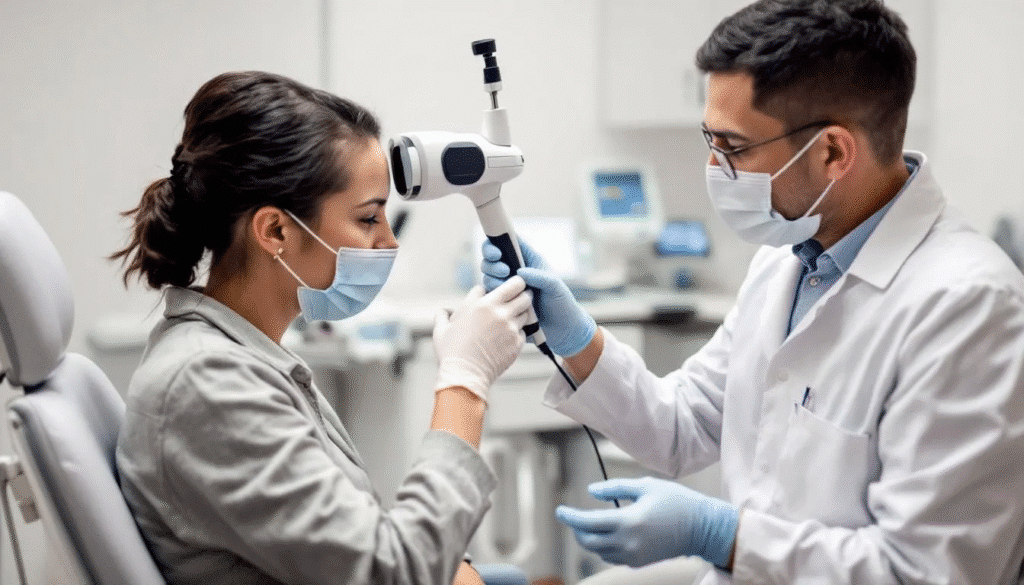
Dutasteride for Severe Cases
Dutasteride represents a more potent alternative to finasteride, blocking both Type I and Type II 5-alpha reductase enzymes compared to finasteride’s selective Type II inhibition. This results in more complete DHT suppression and potentially superior results for men with aggressive pattern baldness. Dutasteride may be considered for those seeking to treat baldness when other options have failed.
While not FDA-approved specifically for hair loss, dutasteride is sometimes prescribed off-label at doses of 0.5mg daily. The more complete DHT suppression may lead to enhanced hair regrowth but also increases the risk of side effects compared to finasteride.
Spironolactone for Women
Spironolactone offers an effective option for women experiencing hormonal hair loss, particularly those with elevated androgen levels or PCOS. This medication works as an androgen receptor blocker, preventing DHT from binding to hair follicles.
Typical dosing ranges from 50-200mg daily, with most women starting at lower doses and gradually increasing based on response and tolerance. Regular monitoring is required as spironolactone can affect electrolyte levels and blood pressure. The medication is not suitable for women planning pregnancy.
While some alternative therapies such as essential oils or folic acid supplements are popular, there is not enough evidence to support their effectiveness for hair regrowth or to treat hair loss compared to FDA-approved treatments.
Advanced Professional Procedures
For those seeking more dramatic results or dealing with advanced hair loss, several professional procedures offer promising outcomes.
Modern hair transplant surgery has evolved significantly, offering natural-looking results for appropriate candidates. Follicular Unit Extraction (FUE) involves harvesting individual hair follicles from donor areas and transplanting them to thinning regions, while Follicular Unit Transplantation (FUT) removes a strip of scalp tissue for follicle extraction.
FUE typically results in less visible scarring and faster recovery, while FUT can be more cost-effective for large areas requiring coverage. Results become visible after 6-12 months as transplanted follicles establish new growth cycles in their new locations.
Ideal candidates have sufficient donor hair density, realistic expectations, and stable hair loss patterns. A board certified dermatologist or plastic surgeon specializing in hair restoration should evaluate candidacy and discuss expected outcomes.
Low-Level Laser Therapy (LLLT)
FDA-cleared LLLT devices use specific wavelengths of red light to stimulate cellular activity in hair follicles. These treatments can be performed in clinical settings or using at-home devices approved for consumer use.
Clinical studies suggest LLLT can increase hair density and reduce shedding when used consistently over 6-12 months. The treatment is considered safe with minimal side effects, though results are generally less dramatic than pharmaceutical interventions.
Microneedling for Hair Stimulation
Microneedling involves using a derma roller with 1.5mm needles to create controlled micro-injuries in the scalp. This process is thought to stimulate growth factors and improve the absorption of topical treatments like minoxidil.
Studies suggest that weekly microneedling sessions combined with minoxidil may produce superior results compared to minoxidil alone. The procedure should be performed with sterile technique and appropriate needle depth to avoid scalp damage.
Corticosteroid Injections
For alopecia areata and other inflammatory causes of hair loss, corticosteroid injections directly into affected areas can suppress the autoimmune response and promote hair regrowth. Treatments are typically administered every 4-6 weeks until regrowth occurs.
While effective for many patients with alopecia areata, corticosteroid injections may cause temporary scalp atrophy or pain at injection sites. This treatment approach requires ongoing medical supervision to monitor for potential side effects.
Natural Methods to Stimulate Hair Regrowth
Natural approaches to reverse thinning hair can complement medical treatments or serve as standalone interventions for those preferring non-pharmaceutical options. Home remedies such as scalp massage, essential oils, and dietary changes can support hair regrowth for some individuals.
Scalp Massage for Improved Circulation
Regular scalp massage represents one of the simplest natural methods to promote hair growth. Spending 4-5 minutes daily massaging your scalp with moderate pressure can improve blood circulation to hair follicles, potentially enhancing nutrient delivery and waste removal. Regular scalp massage and other relaxation techniques may also help reduce stress, which is known to negatively impact hair health.
Use your fingertips (not nails) to apply gentle pressure in circular motions across your entire scalp. Some studies suggest that consistent scalp massage over 24 weeks can increase hair thickness, though results are modest compared to medical treatments.
Consider incorporating scalp massage into your hair care routine during shampooing or while applying topical treatments. This can enhance the absorption of active ingredients while providing the circulatory benefits of massage.
Essential Oils with Scientific Support
Several essential oils have demonstrated promising results for hair growth in clinical studies. Rosemary oil has shown particular promise, with one study finding that 3.7mg/ml rosemary oil applied daily was as effective as 2% minoxidil for promoting hair growth after 6 months of use.
Pumpkin seed oil represents another natural option, with studies suggesting that 400mg daily oral supplementation can improve hair count and thickness in men with mild to moderate hair loss. The oil’s anti-androgenic properties may help reduce DHT’s effects on hair follicles.
When using essential oils topically, always dilute them in a carrier oil such as jojoba or coconut oil to prevent scalp irritation. Apply the mixture to affected areas and leave on for at least 30 minutes before washing out.
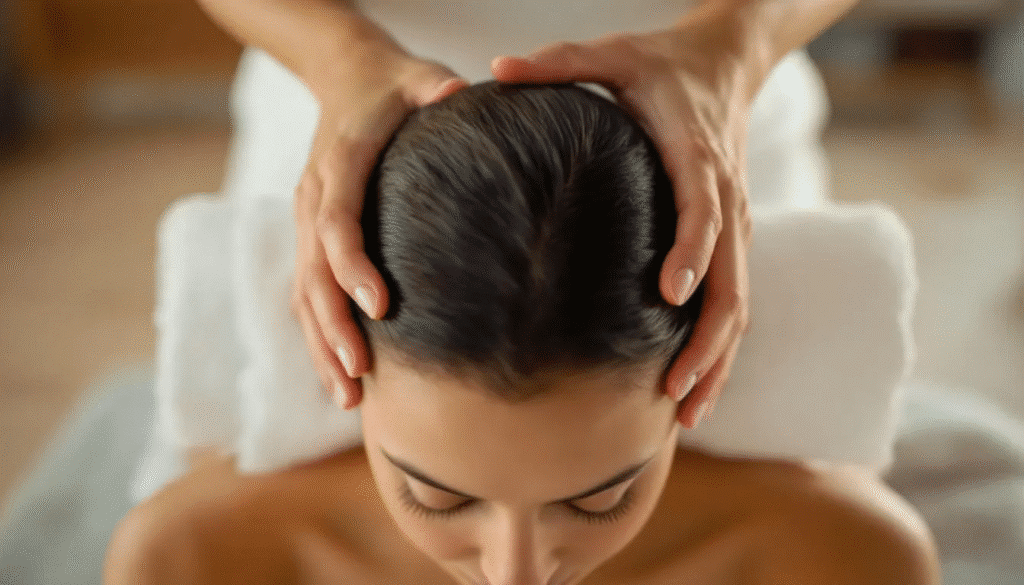
Nutrition-Based Hair Recovery
Addressing nutritional deficiencies through diet can significantly impact hair health and growth. Iron-rich foods are particularly important, especially for women experiencing hair thinning. Excellent sources include beef liver, spinach, lentils, and lean red meat.
Biotin, a B-vitamin essential for hair health, can be obtained from eggs, almonds, sweet potatoes, and avocados. While biotin deficiency is rare, supplementation up to 2.5mg daily may benefit those with compromised hair growth, though more research is needed to establish optimal dosing.
Protein intake is crucial since hair is primarily composed of keratin, a protein structure. Ensure adequate protein consumption from sources like fish, lean meats, legumes, and quinoa to support healthy hair structure and growth.
Nutritional Supplements for Hair Recovery
Strategic supplementation can address specific nutritional gaps that may be contributing to hair thinning.
Omega-3 Fatty Acids for Follicle Health
Omega-3 fatty acids play important roles in reducing inflammation and supporting cellular health throughout the body, including hair follicles. Fish oil supplements providing 1000mg daily of combined EPA and DHA can help address deficiencies and support overall hair health.
For vegetarians and vegans, flaxseed oil or algae-based omega-3 supplements offer plant-based alternatives. These fatty acids may help reduce inflammation around hair follicles and support the structural integrity of hair shafts.
Vitamin D3 for Hair Follicle Function Learn more about how Minoxidil works for hair loss and its effects on hair follicles.
Vitamin D deficiency has been linked to various types of hair loss, particularly in women. This vitamin plays crucial roles in hair follicle cycling and immune function. Most adults benefit from 2000-4000 IU daily, especially those with limited sun exposure.
A blood test can determine your current vitamin D status and help guide appropriate supplementation levels. Those with severe deficiency may require higher initial doses under medical supervision.
Zinc for Protein Synthesis
Zinc is essential for protein synthesis and DNA production, both crucial for healthy hair growth. The recommended daily intake is 8mg for women and 11mg for men. Good dietary sources include oysters, beef, pumpkin seeds, and chickpeas.
Excessive zinc supplementation can interfere with copper absorption and cause other imbalances, so it’s important not to exceed recommended doses without medical supervision. Signs of zinc deficiency include slow wound healing, frequent infections, and changes in taste or smell.
Collagen Peptides for Hair Structure
Collagen provides amino acids that serve as building blocks for hair proteins. While your body naturally produces collagen, production declines with age. Supplementing with 10-20g daily of collagen peptides may help strengthen hair structure and reduce breakage.
Marine collagen is often preferred for hair and skin benefits due to its smaller molecular size and easier absorption. Mix collagen powder into smoothies, coffee, or other beverages for easy incorporation into your daily routine.
Lifestyle Changes to Stop Further Thinning
Preventing additional hair loss is often as important as promoting regrowth, and several lifestyle modifications can significantly impact hair health.
Stress Reduction for Hormonal Balance
Chronic stress elevates cortisol levels, which can disrupt normal hair growth cycles and contribute to increased shedding. Implementing effective stress management techniques is crucial for maintaining healthy hair.
Meditation, even just 10-15 minutes daily, can help lower cortisol levels and improve overall stress resilience. Regular yoga practice combines physical activity with mindfulness, offering dual benefits for stress reduction and improved circulation.
Consider therapy or counseling if you’re dealing with significant life stressors that may be contributing to hair loss. Professional support can provide tools for managing stress more effectively while addressing underlying issues that might be affecting your overall health.
Smoking Cessation for Scalp Health
Smoking significantly impacts hair health by reducing blood circulation to the scalp and increasing oxidative stress throughout the body. The chemicals in cigarettes can damage hair follicles and accelerate the progression of androgenetic alopecia.
Quitting smoking improves circulation within weeks, potentially enhancing the effectiveness of other hair loss treatments. If you need support quitting, consult your healthcare provider about smoking cessation programs or medications that can help.
Sleep Optimization for Growth Hormone Production
Quality sleep is essential for proper hair growth hormone production and cellular repair processes. Aim for 7-9 hours of consistent, quality sleep each night to support optimal hair growth cycles.
Create a sleep-friendly environment by keeping your bedroom cool, dark, and quiet. Establish a consistent bedtime routine and avoid screens for at least an hour before sleep to improve sleep quality.
Sleep disorders like sleep apnea can significantly impact hair health by disrupting growth hormone production and increasing stress on the body. If you suspect a sleep disorder, consult a healthcare provider for proper evaluation and treatment.
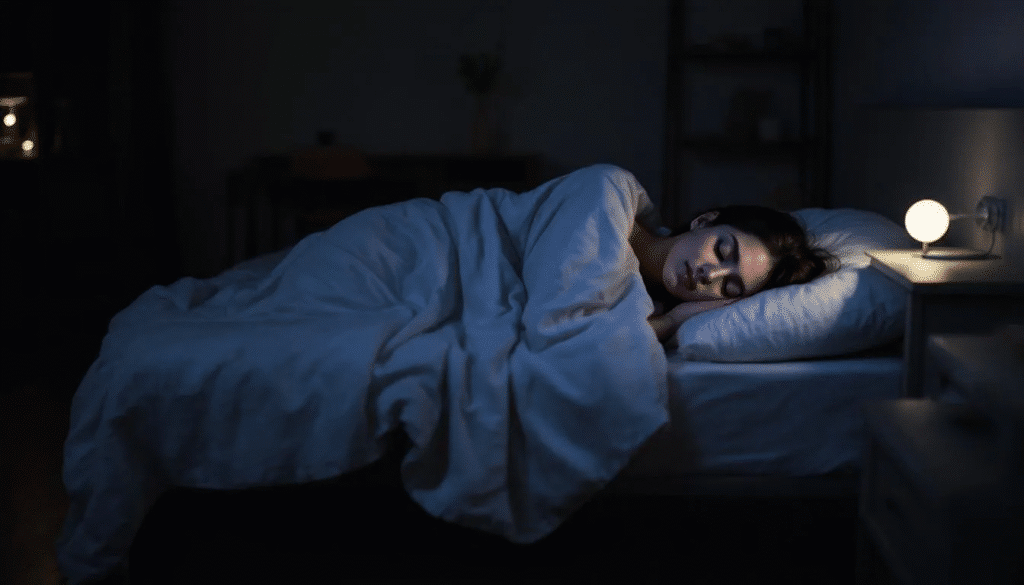
Gentle Hair Care Practices
Avoiding damage to existing hair is crucial when dealing with thinning. Heat styling tools should be used sparingly and never exceed 300°F. Always use a heat protectant product when styling with flat irons, curling irons, or blow dryers.
Tight hairstyles like ponytails, braids, or buns can cause traction alopecia, particularly around the hairline. Alternate hairstyles frequently and avoid pulling hair tightly when styling.
Chemical treatments like perms, relaxers, and frequent coloring can weaken hair structure and increase breakage. If you must use these treatments, space them out and use deep conditioning treatments to minimize damage.
Hair Care Products That Support Regrowth
Selecting appropriate hair care products can support your hair regrowth efforts while protecting existing strands.
Caffeine-Based Shampoos
Caffeine shampoos may help stimulate hair follicles and counteract some effects of DHT when applied topically. While the evidence is still emerging, these products are generally safe and may provide modest benefits as part of a comprehensive treatment plan.
Look for shampoos containing 1-3% caffeine concentration and leave them on the scalp for 2-3 minutes during washing to allow for absorption. These products work best when used consistently as part of your regular hair care routine. If you’re interested in exploring more advanced solutions for hair restoration, learn are hair transplants permanent?
Ketoconazole for DHT Reduction
Ketoconazole 2% shampoo (Nizoral) offers anti-inflammatory and mild anti-androgenic properties that may help reduce DHT activity on the scalp. Use this shampoo twice weekly, alternating with your regular shampoo. If you are considering surgical hair restoration options, learn more about FUE vs FUT hair transplantation.
Leave the ketoconazole shampoo on your scalp for 3-5 minutes before rinsing to allow for maximum absorption. Some users may experience initial scalp dryness, which typically resolves with continued use.
Protein Treatments and Conditioners
Weekly protein treatments can help strengthen weakened hair and reduce breakage, making existing hair appear fuller and healthier. Look for products containing hydrolyzed proteins that can penetrate the hair shaft.
Use deep conditioning treatments regularly to maintain moisture balance, especially if you’re using drying treatments like ketoconazole shampoo. Leave-in conditioners can provide ongoing protection throughout the day. If you are also considering options to enhance facial hair growth, you might want to learn more about the best beard transplant in LA.
Avoiding Harmful Ingredients
Harsh chemicals like sulfates can strip natural oils and irritate sensitive scalps. Choose sulfate-free shampoos, particularly if you’re using topical hair loss treatments that may already cause some dryness.
Avoid products containing alcohol, which can be drying, and be cautious with products containing fragrances or dyes if you have sensitive skin. Simple, gentle formulations are often best for those dealing with hair thinning.
Timeline for Seeing Results
Understanding realistic timelines for hair regrowth helps maintain motivation and set appropriate expectations during treatment.
First Month: Reduced Shedding
During the initial 1-4 weeks of proper treatment, many people notice a reduction in daily hair shedding. This is often the first sign that treatments are beginning to work, even before new growth becomes visible.
If you’re using minoxidil, you may actually experience increased shedding initially as weak, miniaturized hairs are pushed out to make room for stronger growth. This is normal and typically resolves after 2-4 weeks.
Track your progress by paying attention to how much hair you see in your brush, shower drain, and on your pillow. Keeping a simple daily log can help you notice improvements that might otherwise go unnoticed.
Months 2-4: Early New Growth
New baby hair growth typically becomes visible around the hairline and other affected areas during the second to fourth month of consistent treatment. These new hairs may initially appear fine and light-colored but will gradually thicken and darken over time.
This is an encouraging phase where you can actually see evidence that your hair follicles are responding to treatment. The new hairs may initially be difficult to style but represent the foundation of future regrowth.
Continue taking progress photos monthly during this phase, as the gradual nature of hair growth can make it difficult to notice improvements without visual documentation.
Months 6-12: Significant Density Improvement
Between 6-12 months of consistent treatment, most people who are going to respond to therapy will see significant improvements in hair density and thickness. This is typically when friends and family begin to notice positive changes without being told about your treatment.
Medical treatments like finasteride and minoxidil typically reach peak effectiveness around 12 months of use. If you haven’t seen meaningful improvement by this point, it may be time to consult with a healthcare provider about adjusting your treatment approach.
Natural methods may take longer to show dramatic results, but consistent application of scalp massage, appropriate nutrition, and gentle hair care should contribute to overall hair health during this timeframe.
Years 1-2: Maximum Results
Maximum results from most hair loss treatments are typically achieved between 12-24 months of consistent use. This represents the full potential of your chosen treatment regimen, and further improvements beyond this point are usually minimal.
Once you’ve achieved your maximum results, maintaining your treatment regimen is crucial for preserving gains. Discontinuing effective treatments will typically result in the return of hair loss within 3-6 months.
At this point, you might consider adjusting your maintenance routine or exploring additional treatments if you desire further improvement. However, remember that the goal is often halting progression rather than achieving complete restoration.
When to Seek Professional Help
Recognizing when home treatments aren’t sufficient and professional medical intervention is needed can prevent irreversible hair loss and identify underlying medical conditions.
Sudden or Severe Hair Loss
If you’re losing more than 150 hairs daily for more than two weeks, this warrants immediate medical attention. Sudden, dramatic hair loss can indicate underlying medical condition like thyroid disorders, autoimmune diseases, or severe nutritional deficiencies.
Take note of any additional symptoms accompanying the hair loss, such as fatigue, weight changes, skin problems, or changes in menstrual cycles. These can provide important clues about potential underlying causes.
Don’t wait to see if sudden hair loss improves on its own, as early intervention is often crucial for successful treatment and preventing permanent follicle damage.
Circular Bald Patches
Complete hair loss in circular or oval patches suggests alopecia areata, an autoimmune condition that requires prompt medical attention. Early treatment with corticosteroid injections or other immune system medications can prevent progression and promote regrowth.
Alopecia areata can progress rapidly from small patches to extensive hair loss affecting the entire scalp (alopecia totalis) or even the entire body (alopecia universalis). Quick intervention offers the best chance of preventing this progression.
If you notice any areas of complete hair loss, schedule an appointment with a board certified dermatologist as soon as possible for proper diagnosis and treatment.
Treatment-Resistant Hair Loss
If you’ve been consistently using appropriate treatments for 6-12 months without any improvement in hair shedding or regrowth, it’s time to consult a healthcare professional. You may need stronger prescription treatments, combination therapy, or evaluation for underlying medical conditions.
A dermatologist can perform a thorough evaluation including blood tests to check for hormonal imbalances, nutritional deficiencies, thyroid disorders, and autoimmune conditions that might be contributing to treatment resistance.
They may also recommend a scalp biopsy to definitively diagnose the type of hair loss and rule out scarring alopecias that require different treatment approaches.
Scalp Problems Accompanying Hair Loss
Hair loss accompanied by scalp irritation, redness, scaling, pain, or burning requires medical evaluation. These symptoms may indicate inflammatory conditions, infections, or scarring alopecias that need specific medical treatments.
Conditions like lichen planopilaris, frontal fibrosing alopecia, or scalp psoriasis can cause permanent hair loss if not properly treated. Early diagnosis and appropriate treatment can often halt progression and preserve remaining hair.
Never ignore scalp symptoms in favor of treating hair loss alone, as addressing the underlying scalp condition is often necessary for successful hair regrowth.
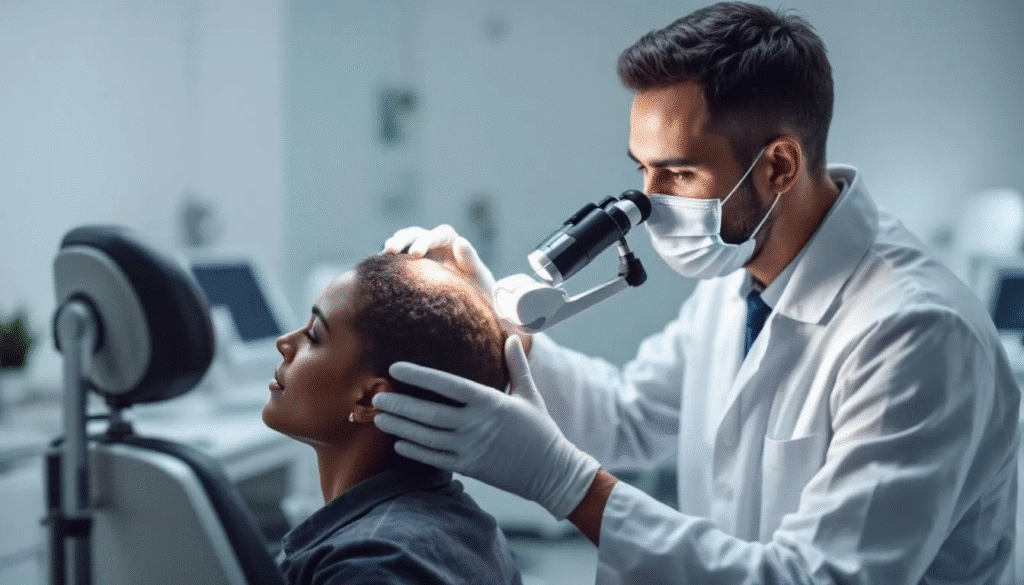
Understanding when to seek professional help ensures that treatable conditions are addressed promptly and that you receive the most effective treatments for your specific situation. A healthcare provider can prescribe treatments that aren’t available over the counter and provide personalized guidance based on your individual medical history and needs.
Remember that reversing thinning hair is often possible with the right approach, but success depends on accurate diagnosis, appropriate treatment selection, and consistent implementation. Whether you start with natural methods, medical treatments, or a combination approach, the key is beginning treatment early and maintaining realistic expectations about timelines and outcomes.
The journey to reverse thinning hair requires patience and persistence, but with the proven methods outlined in this guide, you have the tools needed to take control of your hair health and work toward the fuller, healthier hair you desire.
Introduction to Hair Loss
Hair loss, or alopecia, is a widespread concern that affects both men and women at various stages of life. Whether you notice gradual thinning hair, sudden hair shedding, or more pronounced baldness, the experience can be distressing and impact your confidence. Hair growth is a complex process that relies on healthy hair follicles, balanced hormones, and proper nutrition. Each hair follicle goes through cycles of growth, rest, and shedding, and disruptions to this cycle can lead to noticeable hair loss.
There are many reasons why hair may thin or fall out, including genetics, hormonal imbalances, nutritional deficiencies, and underlying medical conditions. For some, hair loss is a natural part of aging, while for others, it may signal a treatable health issue. Understanding the root cause of your hair loss is the first step toward finding effective treatments and supporting hair regrowth. With the right approach, many people can slow, stop, or even reverse thinning hair and restore their hair’s health and vitality.
Medical Conditions that Cause Hair Loss
A variety of medical conditions can lead to hair loss, each affecting the hair follicles in different ways. Androgenetic alopecia, often called male or female pattern baldness, is the most common cause and results in progressive hair thinning and baldness in both men and women. This condition is driven by genetic factors and hormonal changes that cause hair follicles to shrink over time.
Alopecia areata is another significant cause, where the immune system mistakenly attacks hair follicles, leading to patchy hair loss on the scalp or other areas of the body. Telogen effluvium is a condition marked by excessive hair shedding, often triggered by physical or emotional stress, illness, or major life changes. This type of hair loss is usually temporary but can be alarming.
Other medical issues, such as thyroid disorders, iron deficiency anemia, and certain skin conditions like psoriasis or eczema, can also cause hair thinning or baldness. These conditions may disrupt the normal function of hair follicles, leading to increased hair shedding or difficulty with new hair growth. Identifying and treating the underlying medical condition is essential for restoring healthy hair and preventing further loss.
Hair Thinning in Women
Hair thinning in women is a common but often overlooked issue that can have a significant emotional impact. Unlike men, who typically experience a receding hairline or bald spots, women usually notice diffuse thinning across the top of the head or a widening part. Female pattern hair loss is the most frequent cause, often linked to hormonal imbalances, genetics, and aging. Events such as pregnancy, menopause, and polycystic ovary syndrome (PCOS) can trigger hormonal changes that disrupt the normal hair growth cycle, leading to increased hair shedding and thinning.
Nutritional deficiencies, particularly in iron, vitamin D, and certain B vitamins, are also common contributors to hair thinning in women. Stress, both physical and emotional, can further exacerbate the problem by pushing more hair follicles into the resting phase, resulting in noticeable hair loss. Women may also experience hair thinning as a side effect of medications or underlying medical conditions such as thyroid disorders.
Addressing hair thinning in women often requires a multifaceted approach, including medical treatments, dietary changes, and gentle hair care practices. Consulting with a healthcare provider can help identify the underlying cause and develop a personalized plan to promote hair regrowth and restore hair health.
Hair Thinning in Men
For men, hair thinning often begins with a receding hairline or thinning at the crown, eventually progressing to more extensive baldness if left untreated. Male pattern baldness, or androgenetic alopecia, is the leading cause and is strongly influenced by genetics and the effects of the hormone dihydrotestosterone (DHT) on hair follicles. Over time, DHT causes hair follicles to shrink, producing finer, shorter hairs until they stop growing altogether.
Other factors that can contribute to hair thinning in men include stress, poor nutrition, and certain medical conditions such as iron deficiency anemia or thyroid disorders. Lifestyle habits, such as smoking or frequent use of harsh hair products, can also negatively affect hair health and accelerate hair loss.
Early intervention is key for men experiencing hair thinning. Medical treatments like topical minoxidil and oral finasteride have been shown to slow or even reverse hair loss in many cases. Adopting a healthy lifestyle, managing stress, and using gentle hair care products can further support hair regrowth and help maintain a fuller, healthier head of hair.
Essential Oils for Hair Growth
Essential oils have gained popularity as natural remedies to promote hair growth and treat thinning hair. Certain oils, such as rosemary, peppermint, and lavender, have been studied for their potential to stimulate hair follicles and encourage new hair growth. Rosemary oil, in particular, has shown promise in clinical studies, with results comparable to some over the counter topical treatments for hair loss.
To use essential oils safely, always dilute them in a carrier oil like coconut, jojoba, or argan oil to prevent scalp irritation. Gently massage the mixture into areas where hair is thinning, leave it on for at least 30 minutes, and then wash it out with a mild shampoo. Consistency is key—regular application over several months is often needed to see noticeable results.
While essential oils can be a valuable addition to your hair care routine, it’s important to remember that more research is needed to fully understand their effectiveness. They are best used as part of a comprehensive approach to hair regrowth, alongside proven medical treatments and healthy lifestyle habits. If you experience any negative effects, such as redness or itching, discontinue use and consult a healthcare professional.

